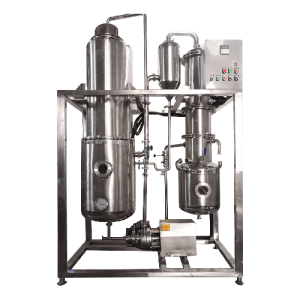A falling film evaporator refers to a concentration and evaporation device used in industries. It is applicable for the concentration and evaporation of water, organic solvents and solutions in the pharmaceutical, food, chemical, light industries and other industries, and especially suitable for heat sensitive materials and materials with higher concentration and higher viscosity. Generally, a falling film evaporator is composed of an evaporator, a separator, a preheater, a condenser and a condensate tank.

Advantages of a Falling Film Evaporator
A falling film evaporator can be widely used in industrial, chemical, biochemical, and other fields. The reasons why it has become so well-received are concluded as follows:
- The heat transfer coefficient is relatively large because the material in the heat exchange tube is in the film state and has a fast flow rate.
- The low temperature difference can be selected, since the pipe material flows downward along the inner wall of the pipe by its own gravity.
- The chemical properties of heat sensitive materials won’t be affected because of the short residence time of the raw material in the heat exchange tube.
- The surface state of the heat exchange tube hardly affects the boiling of the material, because it exhibits convection boiling after the tube material is heated.
- It can save energy because the pipe side material is almost in the ambient temperature without pressure drop.
Disadvantages of a Falling Film Evaporator
Even though there are many advantages of a falling film evaporator, its disadvantages can’t be ignored as well, which will help us have a better understanding of the equipment and use it more properly.
- It is necessary to ensure that the inner wall of the heat exchange tube of the equipment is completely wet but the membrane is not too thick. It is necessary to carry out a very accurate design calculation of the material feed amount and the length of the heat exchange tube to meet such requirements;
- The equipment procurement cost is very high due to high design and manufacturing requirements;
- Falling film evaporators are not applicable to materials that are prone to fouling or contain solid suspended matter.
Classifications of Falling Film Evaporators
There are several kinds of falling film evaporators: single effect of falling film evaporator, double effect of falling film evaporator, three effect of falling film evaporator, four effect of falling film evaporator, five effect of falling film evaporator, six effect of falling film evaporator. It is suitable for milk, glucose, xylose, pharmaceutical, chemical, bioengineering, environmental protection engineering Low-temperature concentration in industries such as waste liquid recovery.
Difference Between a Rising and Falling Film Evaporator
The falling film evaporator and rising film evaporator are both devices used to concentrate or extract substances. But there are some differences between them.
- The falling film evaporator can evaporate substances that are higher-concentration, higher-viscosity, and heat-sensitive substances.
- The working system of the falling film evaporator is different from the rising film evaporator’s working system. During the working of the falling film evaporator, liquid goes from the top to the bottom. Whereas, during the working of the rising film evaporator, liquid goes from the bottom to the top.
How to Use a Falling Film Evaporator Properly?
A falling film evaporator can continuously work under vacuum and low temperature conditions, with high evaporation capacity, energy saving and consumption reduction, low operating cost.
Falling Film Evaporators’ Troubleshooting
The falling film evaporators are greatly well-received in many industries as a high efficient evaporation and concentration equipment. However, when the falling film evaporators are
What is a Falling Film Evaporator?
A falling film evaporator is one of the most effective evaporators and well-received in many industries. So what is a falling film evaporator exactly? The
Falling Film Evaporator VS. Rotary Evaporator
Introduction to Falling Film Evaporators Falling film evaporators are efficient evaporation equipment widely used for the evaporation and concentration of evaporative material, water, organic solvents
What is a Falling Film Evaporator Used for?
A falling film evaporator refers to a concentration and evaporation device used in industries. As the highly efficient evaporation equipment, falling film evaporators are more
How does a Falling Film Evaporator Work?
In the industrial field, there are always some substances which need to be extracted or concentrated. Therefore, there are also so many devices or techniques